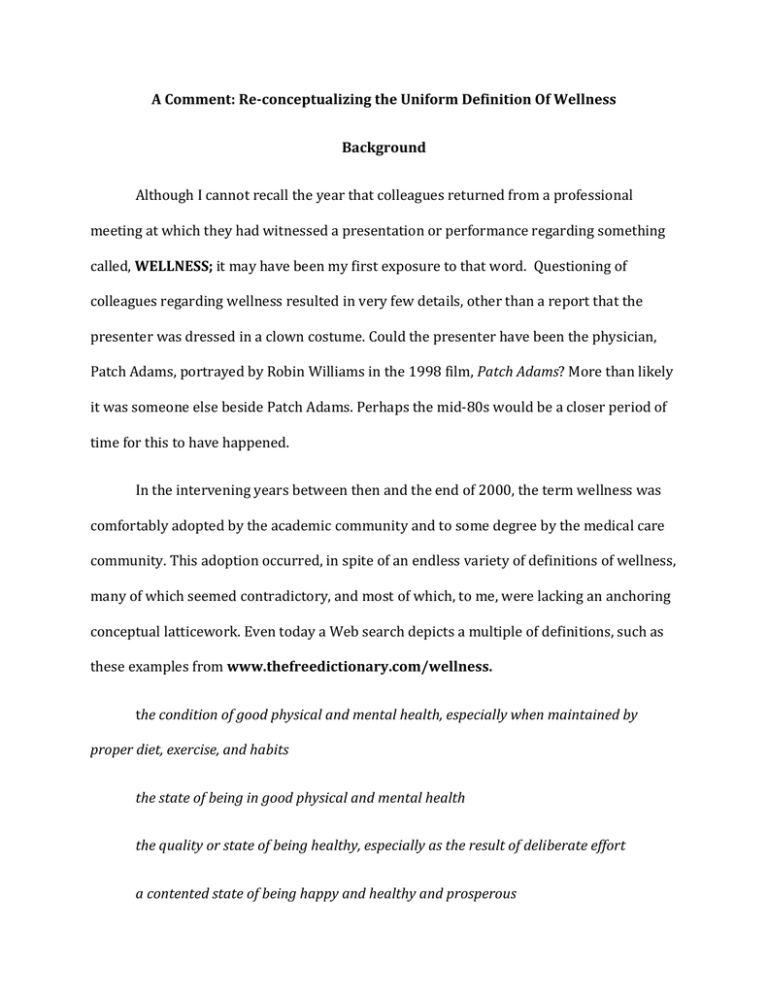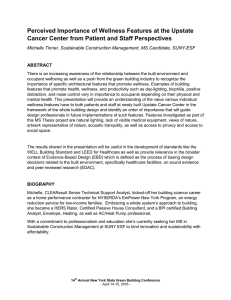A Comment: Re-conceptualizing the Uniform Definition Of Wellness Background
advertisement

A Comment: Re-conceptualizing the Uniform Definition Of Wellness Background Although I cannot recall the year that colleagues returned from a professional meeting at which they had witnessed a presentation or performance regarding something called, WELLNESS; it may have been my first exposure to that word. Questioning of colleagues regarding wellness resulted in very few details, other than a report that the presenter was dressed in a clown costume. Could the presenter have been the physician, Patch Adams, portrayed by Robin Williams in the 1998 film, Patch Adams? More than likely it was someone else beside Patch Adams. Perhaps the mid-80s would be a closer period of time for this to have happened. In the intervening years between then and the end of 2000, the term wellness was comfortably adopted by the academic community and to some degree by the medical care community. This adoption occurred, in spite of an endless variety of definitions of wellness, many of which seemed contradictory, and most of which, to me, were lacking an anchoring conceptual latticework. Even today a Web search depicts a multiple of definitions, such as these examples from www.thefreedictionary.com/wellness. the condition of good physical and mental health, especially when maintained by proper diet, exercise, and habits the state of being in good physical and mental health the quality or state of being healthy, especially as the result of deliberate effort a contented state of being happy and healthy and prosperous A wellness program is a noble endeavor designed to improve the general health of employees and other stakeholders within an organization In searching for clarity, I turned to a recognized wellness authority on my campus. In a conversation that followed, I was introduced to the two salient characteristics that made, in his mind, wellness both unique and efficacious. These were: 1.) Wellness was not interesting in (or focused on ) issues of morbidity or premature mortality, but only on a fuller expressions of human potentialities; and 2.) Wellness was both a process and an outcome This latter contention occurred when wellness professionals, employing didactic/ behavioral change/consolatory strategies, could influence receptive individuals to adopt a wellness-enhancing life style. Once adopted, this life style would result in a sense of wellness. Succinctly said, wellness begets wellness. Before parting, I also enquired how wellness could be marketed to corporations on the premise of decreasing their health insurance costs, yet itself not be interested in aspects of morbidity — the explanation was less than succinct, but it too leaned in the direction of a "healthier life style." At this point nothing was mentioned about the fullest expression of one's potentialities. Following the discussion detailed above, I observed the practice of wellness in an ongoing programs within a large teaching hospital adjacent to campus. In spite of the contention made regarding wellness' minimal interest in issues of morbidity and premature mortality, its focus, appeared to me, to be centered on risk reduction activities related to adult-onset chronic condition. In my recollection nothing appeared indicating a focus on the enhancement of potentialities. A Uniform Definition Of Wellness In a manner reminiscent of the nascent World Health Organization's attempt to formulate and disseminate a uniform definition of health (circa 1947), a similar attempt, relative to wellness, was undertaken under the auspicious of the President's Council on Physical Fitness & Sports. The definition that was developed is as follows, and can be found In Series 3. No.15, December 2001, issue of the Counsel's publication, Research Digest. (the current name of the Council now includes, Nutrition). Wellness is a multidimensional state of being describing the existence of positive health in an individual as exemplified by quality of life and a sense of well-being In comparison to other definitions of wellness, I deeply appreciate the Council's decision to include two touch-points often missing from other definitions of wellness. These points being "quality of life" and "sense of well-being". These points alone give more focus to the concept of wellness than definitions mentioning only "positive health" as being the epicenter of the wellness movement and its programmatic undertakings. Unfortunately, however, in my opinion, there is a missing latticework that is needed to give body to the basis from which a quality of life and a sense of well-being take root. It is my hope to depict this latticework, placing emphasis on the source of the latticework and the fullest expression of one's potentialities. Re-conceptualizing the Uniform Definition of Wellness In preparation for an introduction of a re-conceptualized definition of wellness, two decisions needed resolution. The first was the adult age group on which to focus; while the second related as to when to introduce the refined definition — before or after a schematic depicting the interplay of the factors that form its latticework? My decision was to focus on wellness in older adulthood, followed then by a visual depiction of the latticework and the redefined definition nearest the end. Growth And Developmental Expectations For Older adulthood As depicted In Figure 1, entitled Wellness Re-conceptualized, the development expectations of the life course anticipated for persons within late adulthood are relatively few in number and, of course, generally stated. Their accomplishment is not, however, based simply on the passage of time, but rather on the reciprocal interplay between relevant roles, role-related behavioral patterns, and applicable resources. Figure 1 further depicts the interplay of these factors with one’s ability to experience a sense of well-being during older adulthood. As a point of reference, the label, sense of well-being, equates with the gerontologist’s preference, sense of life satisfaction, and Erik Erikson’s concept of a sense of integrity. Regardless of the label, it reflects that one’s life is viewed as having been lived as well as could be done under the circumstances encountered, and with the resources at hand. Figure 7. Wellness Re-conceptualized: Older Adulthood © Older adulthood development tasks and roles, role-specific behaviors resources, role fulfillment and a sense of well-being In preparation for a new definition of wellness, let’s dissect Figure 1 from the outside inward: 1. The multicolored outermost ring of the circle is accompanied by six statements, each of which represents a developmental expectation of society, deemed desirable for the older individual’s sense of self-worth, and for the benefit of other individuals, institutions, and programs that have present and future needs. Senescence is a term that relates to the “process of aging over time,” while generativity reflects a willingness on the part of individuals to “pay back” the larger society for its support of their own growth and development. Generativity is usually begun in middle adulthood and carried over into older adulthood. 2. At this point we will delay addressing the six variously colored, narrower rings that lie beneath the outer ring, and address the several small action figures (icons). These icons represent the multiple roles , some of which were carried from earlier stages of adulthood or are assumed during late adulthood. Regardless, for a role to have validity, it must be capable of demonstrating role-related behaviors that are functional and acceptable to society, and are enjoyable to the individual. Once undertaken, individuals are capable of achieving a sense of role fulfillment. Note the reciprocity that can result between societal-based expectations for late adulthood growth and development, and the roles played by many older adults. For example, the societal expectation for an older experienced employee to mentor a younger/less experienced employee becomes a role that awaits fulfillment. Once accomplished, society has gained a new resource — a more competent younger adult —, the mentor feels an enhanced sense of generativity, and the mentee is better positioned for advancement and opportunities to mentor others in the future.. 3. The six smaller colorful circles of Figure 1 represent each of the dimensions of one’s holistic health. Role fulfillment can, and usually does, require resources from the physical dimension (strength, coordination, sensory acuity, recuperative capabilities, etc); emotional dimension (affective feeling such as empathy, fear, anger, love, confidence, and desire for challenge); social dimension (communication skills, conflict resolution, shared interests, social skill sets, as well as access to others within a safe environment); intellectual dimension (abilities to analyze, hypothesize, compute, postulate, conceptualize, and test for validity of today's mass of information); occupational dimension (project orientation, team-building skills, delegation/acceptance of responsibilities, time management, and acceptance of constructive criticism); and the spiritual dimension (insight to one's core values, voluntary membership in a community of faith, a degree of altruism, ability to be inclusive, acceptance of diversity, and a commitment to stewardship). Hopefully, you are in a position to see that an even additional level of reciprocity is possible. This would, of course, be the reciprocity that exists between societal growth and development expectations, roles, role-related behaviors, role fulfillment, and the resources, both intrinsic and extrinsic, that support role-related behavioral patterns. When combined effectively and consistently, a sense of well-being, a life well lived, and a sense of integrity will have been earned. The sense of well-being, of course, holds resciprosity with all other components within the latticework. The maximizing of potentialities will have been accomplished. © Wellness Re-conceptualized The existence of WELLNESS reflects the consistent ability to apply the widest array of resources, both intrinsic and extrinsic, to the activities that sustain role fulfillment—thus fostering the mastery of developmental expectation, and the experiencing of a truly deserved sense of well-being. In closing this COMMENT, allow me to share my latest observation of the diversity that can be accommodated by the current uncertainty of wellness' boundaries . This example was noted when visiting in a local pet supply chain where a center-aisle display introduced two new products — WELLNEES (dog food) and WELLNESS (cat food). A later search of the company's Web site featured this unedited product endorsement: Nice consistent poo "Now i know that's a funny title but as a dog owner and lover i always notice my dog's poo. It helps me know if has healthy and if he ate something bad or to much. I have been giving him WELLNESS for close to a year now. Leo's is consistent, small, and not to hard nor soft. It never changes." www.chewy.com/dog/wellness-complete-health- adult/dp/34360?utm_source=goggle In conclusion, the reader's attention is called to the boxed element that appears below. This depicts a derivate of an initial definition of the WELLNESS . The later expands further the interactive nature of wellness with roles, role-relate behaviors, and developmental expectations. Wayne A. Payne ED.D Professor Emeritus of Health Science Ball State University ftwayne41@gmail.com FIGURE 7: Wellness Re-conceptualized © Older adulthood developmental tasks and roles, resources, and a sense of well-being







